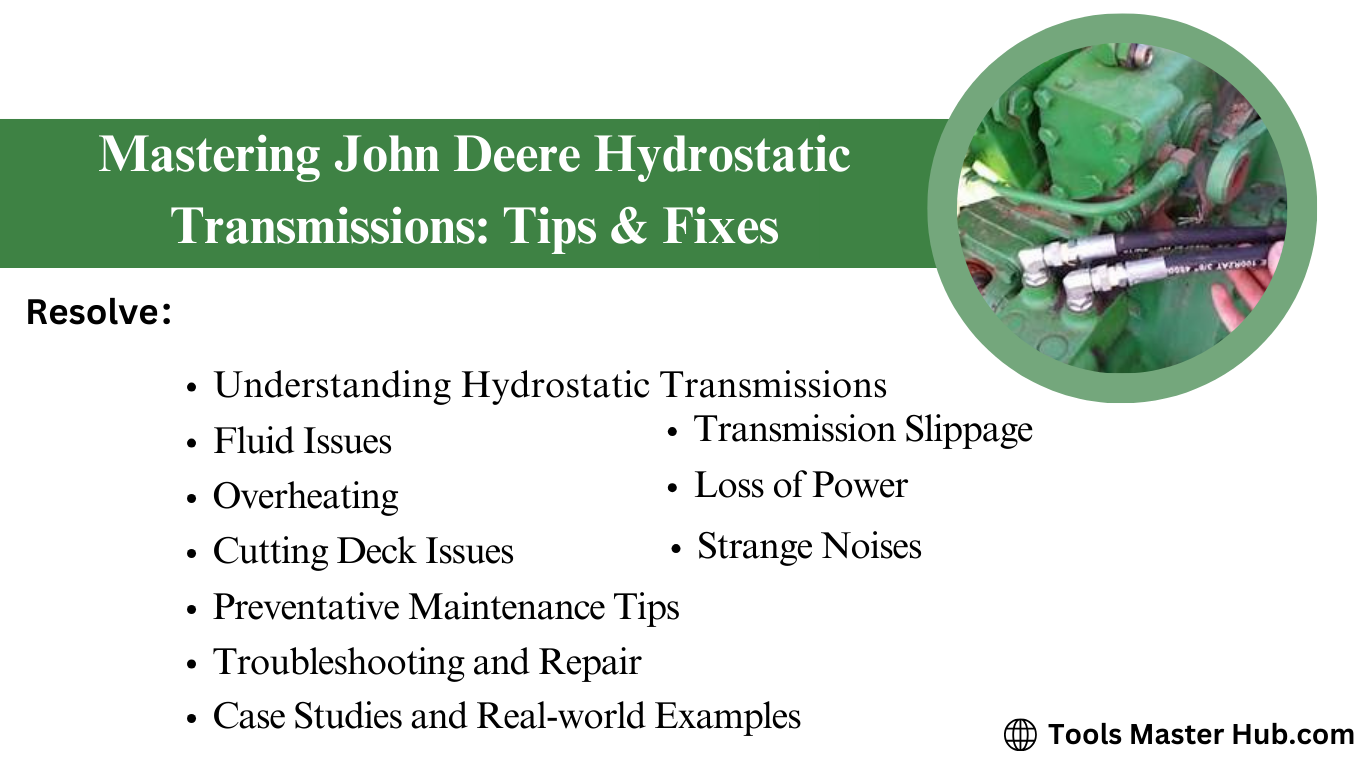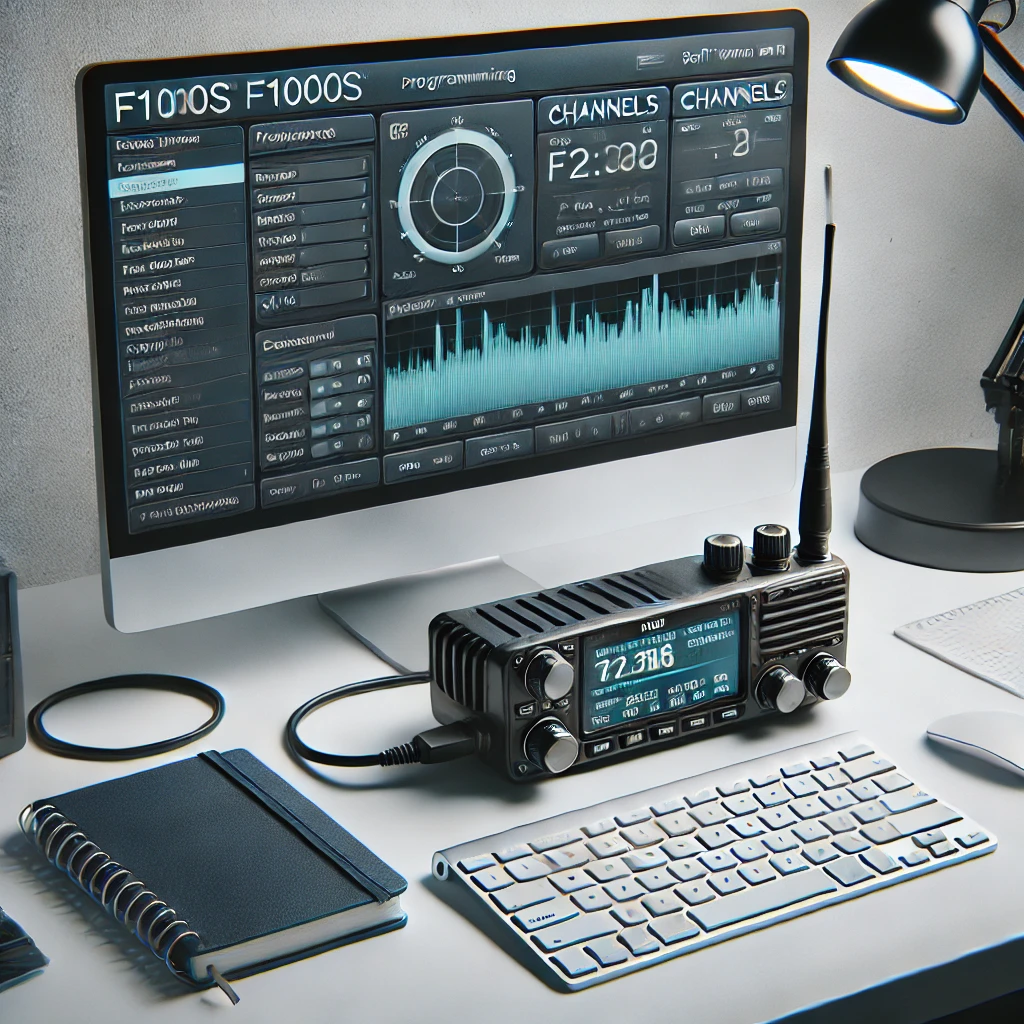1. Introduction
John Deere is a synonym for quality and innovation in the agricultural machinery industry. Established more than 180 years ago, the company has become a symbol of reliability and outstanding performance within this market sector for tractors, harvesters, and other farm equipment. One notable component present in most John Deere tractors is the hydrostatic transmission, which is responsible for regulating motion smoothness and controllability.
John Deere Hydrostatic transmissions are essential for improving the operating efficiency of John Deere tractors. They enable step-less speed changes without requiring manual switching between gears, which is highly beneficial in various farming tasks. However, like any complex machinery, hydrostatic transmissions can experience difficulties that negatively affect their functioning.
This article aims to identify common problems that are experienced with hydrostatic transmission systems on John Deere tractors as well as give appropriate solutions to these problems. Knowing such challenges will help tractor owners maintain their machines properly, resulting in long service life and better performance.
2. Understanding Hydrostatic Transmissions
Hydrostatic transmissions are a type of continuously variable transmission (CVT) that employ hydraulic fluid to transmit power from an engine to the wheels or tracks of a machine.
A hydrostatic transmission functions by converting mechanical energy from an engine into hydraulic energy, which then propels wheels or tracks as they rotate around on their axis due to movement by materials such as the earth being pushed over them by blades attached at an angle perpendicular to ground level under which said materials have been placed for excavation purposes or cutting down trees, etcetera The basic principle behind the operation of these transmissions involves both a hydraulic pump and motor components.
Unlike manual transmissions, where shifting gears is done manually by the operator, hydrostatic ones allow an infinite number of gear ratios within a certain range. They have infinitely variable speed ranges and are thus very good for applications that require accurate control, such as mowing, tillage, and plowing.
How Hydrostatic Transmissions Differ from Other Types of Transmissions
Hydrostatic transmissions are very different from both manual and automatic transmissions. Operators will shift through gears in a set by using clutches and stick shifts in manual transmission. On the other hand, automatic transmissions employ complex systems consisting of gears, clutches, and hydraulic fluid to automatically change gears as per the speed of the car as well as its load.
On the contrary, John Deere’s hydrostatic transmission problems function with hydraulic pressure. Generally, this consists of a pump producing flow and a motor receiving this flow, which converts it back into mechanical energy. The output speeds and torques span across wide ranges owing to the variable displacement of the pump and motor, giving unremarkable command over vehicle motion.
Advantages of Hydrostatic Transmissions in Tractors
Hydrostatic transmissions have several benefits that make them particularly suitable for use in agricultural machinery:
Smooth Operation: Continuous gear-shifting ensures seamless speed adjustments, which improves operator comfort by reducing jerks.
Versatility: These are highly flexible types of transmissions that allow tractors to perform different tasks with high precision.
Ease of Use: Even farmers who haven’t had any training can use hydrostatic tractors because they come with foot pedals or hand controls, enabling farmers to operate at their own pace without much strain placed upon them due to these controls being user-friendly enough, allowing drivers from varying levels of experience drive smoothly without having difficulty during engagement
Enhanced Productivity: Farming efficiency may be increased if operators do not have to shift gears constantly while maintaining constant speed throughout all sorts of terrains, including hillsides where they need power extractions occurring upward slopes. Downhill ones act against such applications; thereby, if given another chance, people would rather choose these systems anyway since there is no difference between various topographies. Just name it; what counts most must be kept up-to-date at all times!!
To delve into common issues experienced by John Deere tractor owners, it is important first to understand the basics and advantages of hydrostatic transmissions. In the succeeding sections, we will look at common problems faced by users of John Deere’s tractors and suggest some effective ways to maintain these essential parts in their optimal condition.
3. Common Problems with John Deere Hydrostatic Transmissions
Hydrostatic transmissions are popular as they are durable and smooth in their operation, but some concerns may hinder their performance. Below are common problems faced by John Deere tractor owners and how to fix them.
Fluid Issues
Low or Dirty Hydraulic Fluid The hydrostatic transmission depends on hydraulic fluid, which is often referred to as the lifeblood. However, over time, this fluid becomes dirty or changes in its composition; hence, it cannot effectively perform its functions. Low levels of fluid can also cause inadequate cooling and lubrication, leading to poor transmission performance.
The Importance of Regular Fluid Checks and Changes Monitoring and changing hydraulic fluid regularly is important for maintaining the health of a good transmission system. Use only the recommended fluids from your manufacturer while following your owner’s manual services schedule. This way, you can avoid many common problems experienced with transmissions.
Overheating
Causes of Overheating Hydrostatic transmissions may overheat due to operating under heavy loads for too long, hot weather conditions, or a lack of cooling provided by the system. Overheating causes a breakdown in hydraulic fluids, which leads to slow performance issues and eventual damage to components.
Signs of Overheating and Preventive Measures It is possible to diagnose overheating by observing such things as an abnormal burning smell, high temperatures in the case of transmission, and reduced performance. For instance, ensuring the proper functioning of your cooling system, including avoiding overloading your tractor and allowing it to cool down during intense operations, and preventing overheating
Transmission Slippage
Causes Slippage happens when a tractor fails to hold speed or power under load. Common examples include worn-out belts, low or dirty transmission oil, or just internal parts wearing out within a gearbox.
How to Diagnose and Fix Slippage Issues To begin with, inspect belts for wear, check belt tension, test oil level, and examine the oil for contamination if any of the basic service checks mentioned here do not help: it could mean that the problem lies within internal transmission and may require professional inspection and repair.
Loss of Power
Potential Causes A noticeable loss of power in a hydrostatic transmission can be due to faulty hydraulic pumps or motors, air in the hydraulic system, or clogged filters. When these problems arise, transmissions are unable to convert hydraulic energy into mechanical motion efficiently.
Troubleshooting Steps The first thing is to check the quality and quantity of hydraulic fluid by changing clogged filters. If this doesn’t resolve the issue, visually inspect the motors as well as pumps for wear or damage. Alternatively, air pockets may also be removed through bleeding hydraulic systems to restore lost power.
Strange Noises
Common Sounds Indicating Problems Whining, grinding, and knocking sounds often suggest something is not right with hydrostatic transmission noises Each sound may indicate different types of errors.
What Each Noise Might Signify and How to Address It
Grinding: This may indicate worn gears or bearings. Check if there are any damaged parts on your gearbox and replace them when necessary.
Whining is often a sign of low hydraulic fluid or air in the system. Eradicate any dirt from oil reservoirs; otherwise, change the oil level where deemed appropriate.
Knocking: This could be due to loose or damaged internal parts. A qualified technician should undertake a thorough examination to identify and correct this problem.
By understanding these common problems along with their solutions, owners of John Deere tractors will ensure that their machines are efficient for longer periods while preventing bigger repairs on minor issues through regular maintenance practices and prompt troubleshooting steps.
For your John Deere hydrostatic transmission to have a long life and run smoothly, preventative maintenance is essential. Here are some important tips for maintaining it:
4. Preventative Maintenance Tips
Regular Fluid Checks and Changes
Checking the fluid regularly is very important. Inspect hydraulic fluid level and quality every month, at least once. Low or dirty fluids can cause great trouble for transmissions. Always follow the manufacturer’s recommendations on hydraulic fluid types as well as the guidance on changing intervals provided in the tractor manual. Regularly changing it helps to retain proper lubrication and cooling that prevent wear and overheating.
Proper Tractor Operation Techniques to Avoid Strain
Proper operation of a tractor can significantly reduce stress on a hydrostatic transmission system. Sudden starts and stops should be avoided because they put extra load on the gears of the transmission. When you are reversing after stopping, take care not to strain your engine too much. To prevent overloading your hydrostatic transmission, use appropriate power settings and speeds for what you do.
Periodic Inspections of Belts, Pumps, and Motors
Frequent inspections of belts, pumps, and motors are crucial in recognizing early signs of wear or damage due to use over time. Look out for signs of wear or tear, such as cracks or fraying, when inspecting your belts, along with confirming that tensioning is okay with them. During inspection, look out for leaks, whether from hydraulic pumps or motors, and strange noises coming from them. Correct these problems when they first appear rather than let them develop into irreparable ones that will be expensive to fix later.
Keeping the Cooling System Clean and Functional
Maintaining a functional cooling system is very necessary to avoid overheating the engine during operation periods. Clean the radiator periodically, together with its cooling fins, so that efficient heat dissipation may be achieved. The cooling fan should be examined alongside other parts to ensure their efficiency. In hot climates or heavy usage conditions, park occasionally so that your transmission cools down, which reduces the chances of overheating.
5. Troubleshooting and Repair
Even with regular maintenance, things can go wrong. Knowing how to troubleshoot and when to seek professional help is critical.
Basic Troubleshooting Steps for Common Issues
Here are some basic troubleshooting steps for common hydrostatic transmission problems:
Fluid Issues: Check hydraulic fluid levels and quality. Add or replace as needed.
Overheating: Look into any possible blockages in the cooling system or malfunctioning. Have the radiator cleaned and checked for a free flow of air.
Transmission Slippage: Examine the condition of your belt along with its tension and test your hydraulic fluid to see if it is contaminated.
Loss of Power: Filters should be examined to check for obstructions, plus there may be air in the system that needs to be bled off. Also, look at pumps and motors as required.
Strange Noises: Identify the noise type (i.e., grinding, whining, knocking), then inspect gears, bearings, belts, etc. that’ll make such a sound.
When to Seek Professional Help
If you have gone through the basics without a solution, consult an expert. Here are signs that it’s time to get a professional involved:
- Persistent or worsening problems despite troubleshooting.
- Severe wear or damage to internal transmission components such as pumps or motors.
- Abnormal sounds persist beyond addressing common causes.
- Advanced repairs require specialized tools and expertise.
- Cost Considerations for Common Repairs
Repair cost estimates vary greatly depending on what is wrong with your hydrostatic transmission. Here are some rough figures about typical repair prices:
Hydraulic Fluid Change: Typically $50–$150, depending on fluid type and amount used.
Belt Replacement: Approximately $100-$300 (including parts + labor).
Pump or Motor Repair/Replacement: Depending on the type of parts required along with their degree of damage, this ranges from $500 to over $2,000.
Professional Diagnostic Fee: Normally, it ranges from $100 to $200; however, it could be waived if you go with any of the recommended repairs.
Consequently, knowing these costs will enable you to make an educated decision on maintenance and repair work while keeping your John Deere tractor in perfect condition.
6. Case Studies and Real-world Examples
Cases of Common Issues Encountered by John Deere Clients
Case Study 1:
Fluid Contamination in a John Deere 1025R Ohio farmer John noticed that his John Deere 1025R was losing power and making a whining sound. He found out that the hydraulic fluid was dirty and had debris present upon inspection. This resulted in insufficient lubrication and poor transmission performance.
Resolution: In this case, the contaminated fluid was drained off before being replaced with the correct hydraulic fluid for this purpose. Further still, he changed the hydraulic filter as well as flushed out any remaining contaminants from the system. The tractor performed much better following these steps and there was no more noise coming from it.
Case Study 2:
Overheating Issues in a John Deere 3025E Georgia small farm owner David faced frequent overheating problems with his John Deere 3025E, especially during prolonged sessions in the summertime. Alongside slow speeds, he experienced fumes emanating from his machine, like something burning.
Resolution: The first thing that David did was clean the radiator thoroughly, checking if any dirt buildup or debris had accumulated on its cooling fins before making sure enough coolant was available and functioning fan spinners also. Also, switching over to a thicker grade of high-temperature hydraulic oil helped prevent overheating issues associated with #2. This improved cooling effectivity; thus, without heavy use, tractors ceased to heat up again.
Case Study 3:
Transmission Fluid Leak in a John Deere X350 Tom is an Illinois homeowner who observed oily spots under where his lawn tractor parked. In addition, the tractor’s performance was becoming poor, and it seemed to generate some sort of annoying charity sound.
Resolution: The leak was identified by Tom, who then went ahead to replace the seal and top up the hydraulic fluid. After completing these repairs, the transmission leak stopped, and the tractor’s performance returned to normal. Additionally, Tom decided that he would be inspected after a certain period to detect any new leaks that may occur early.
Case Study 3:
Transmission Slippage in a John Deere 2025R Part-time landscaper in North Carolina Lisa discovered that her John Deere 2025R was often slipping and losing power while climbing inclined surfaces or carrying heavy loads. This occurred when its transmission made such sounds of whining whenever put under load.
Resolution: Checking on worn-out transmission belts helped Lisa find out that they needed replacement, so she did accordingly, even tensioning them again. Furthermore, when checking all levels of hydraulic fluids, she found out they were low, hence adding recommended manufacturer-specific types of fluids to them. Therefore, this resulted in an adjustment on my part about how I operated my vehicle; no longer did it slip anymore, but instead it went back to being powerful just like before.
How These Issues Were Resolved
The examples exhibited herein reveal just how important regular maintenance is alongside proactive troubleshooting. By promptly dealing with fluid leaks, overheating, slippage, power loss, and weird noises from their John Deer models’ hydrostatic transmissions, common problems were well solved by their respective owners.
It is therefore important for all users to ensure that there are always inspections done regularly on such equipment, thereby enabling one to identify what might be wrong before something costly happens in terms of repair works where necessary and enhancing dependability as well as serviceable limits of tractors.
7. Conclusion
Various agricultural tasks necessitate the efficient and smooth operation of John Deere tractors that have been equipped with hydrostatic transmissions. However, these systems can often develop problems such as fluid contamination, overheating, transmission slippage, loss of power, and strange noises. To prevent these problems, they require regular maintenance, which comprises fluid checks and changes, proper operation techniques, periodic inspections, and keeping the cooling system clean.
Final Tips for Maintaining a Healthy Hydrostatic Transmission
Stay Proactive: Keep inspecting regularly your tractor for early detection of potential issues.
Use Quality Fluids and Parts: For compatibility and performance, always make use of fluids and parts recommended by the manufacturer.
Monitor Performance: These will be changes in performance, noises, or temperatures that indicate hidden complications.
Seek Professional Help When Needed: Do not hesitate to engage a professional when repairs are complicated or recurrent.
Encouragement to Stay Proactive About Maintenance
Keeping up with your John Deere hydrostatic transmission does not need to be intimidating. By being proactive and addressing any issue as soon as it arises, you can be assured that your tractor will serve you reliably and efficiently for years. Regular servicing enhances its life span while also improving its overall efficiency during operation, thus leading to a better outcome in farm work. Be watchful by following those bits of advice given in this article, and then you’re good to go with your John Deere tractor on the farmland.











Leave a Reply